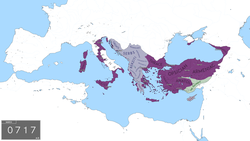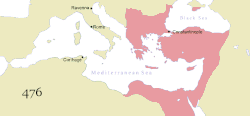
Back عشرين عاما من الفوضى Arabic Εικοσαετής Αναρχία Greek Anarquía de los veinte años Spanish آنارشی دوازدهساله FA Années de chaos French עשרים שנות אנרכיה HE Anarki Dua Puluh Tahun ID Anarchia dei vent'anni Italian 20년의 무정부기 Korean Дваесетгодишна анархија MK
Byzantine Empire | |||||||||
|---|---|---|---|---|---|---|---|---|---|
| 695–717 | |||||||||
 The Byzantine Empire by the end of the Twenty Years' Anarchy in 717 AD. | |||||||||
| Capital | Constantinople | ||||||||
| Common languages | Greek Latin | ||||||||
| Religion | Chalcedonian Christianity | ||||||||
| Government | Monarchy | ||||||||
| Emperor | |||||||||
• 695–698 | Leontius | ||||||||
• 698–705 | Tiberius III | ||||||||
• 705–711 | Justinian II (restored; second term) | ||||||||
• 711–713 | Philippicus | ||||||||
• 713–715 | Anastasius II | ||||||||
• 715–717 | Theodosius III | ||||||||
| History | |||||||||
• First deposition of Justinian II | 695 | ||||||||
• Deposition of Theodosius III | 717 | ||||||||
| |||||||||
| History of the Byzantine Empire |
|---|
 |
| Preceding |
| Early period (330–717) |
| Middle period (717–1204) |
| Late period (1204–1453) |
| Timeline |
| By topic |
|
|
The Twenty Years' Anarchy is a historiographic term used by some modern scholars[1][2][3] for the period of acute internal instability in the Byzantine Empire marked by the rapid succession of several emperors to the throne between the first deposition of Justinian II in 695 and the ascent of Leo III the Isaurian to the throne in 717, marking the beginning of the Isaurian dynasty.